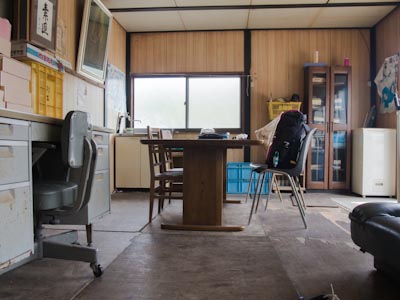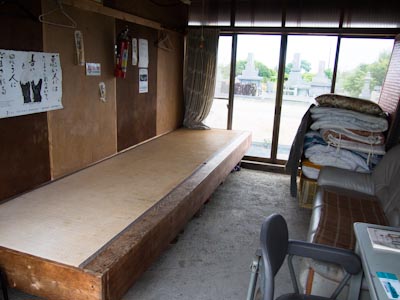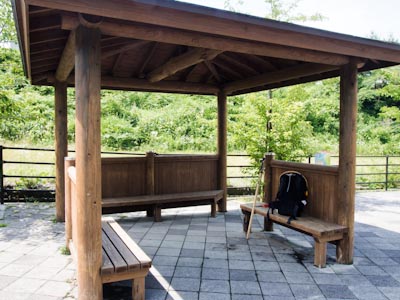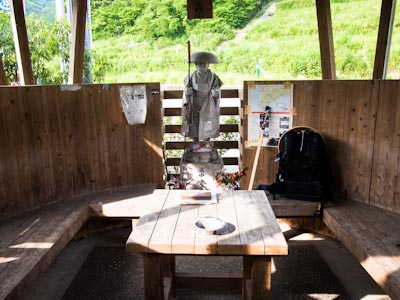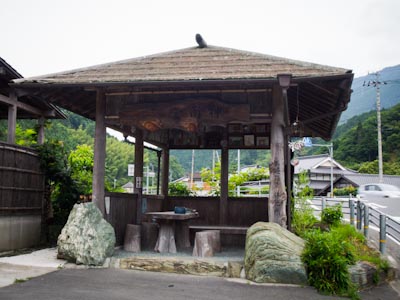Where to Stay Along the Shikoku Pilgrimage
Shikoku Pilgrimage Lodging Recommendations
| Type | Should I Stay? | Description | Full Details |
|---|---|---|---|
| MinshukuView on map | 👍👍👍 | Local guesthouses run by kind, dedicated inkeepers. Wonderful, authentic way to stay overnight. Traditional Japanese accomodations. Affordable way to support the local economy. Often has an option for home-cooked meals. | Learn more about staying at minshuku |
| CampgroundsView on map | 👍👍👍 | For those who want to sleep under the stars. Safe, legal way to pitch a tent along your pilgrimage. Typically costs a small entrance fee which comes with basic facilities (like running water). | Learn more about camping in Shikoku |
| RyokanView on map | 👍👍👍 | Slighly pricier and nicer option for a traditional Japanese stay. Also locally run (often multi-generational businesses). Sometimes has a public bath or onsen. Meals are usually delicious. | Learn more about staying at ryokan |
| Temple Lodgings(Shukubo) | 👍👍👍 | Ryokan-style lodgings on temple grounds. Rare but special experience. Often comes with (optional) temple rites during which you’ll be shown treasures and customs only seen by overnight guests. | Learn more about staying at shukubo |
| HotelsView on map | 👍👍👍 | A more modern and familiar kind of lodging. Typically pricier than minshuku but cheaper than ryokan or shukubo. Sometimes comes with meals or a public bath. Usually western-style accomodations. | Learn more about hotels in Shikoku |
| Free Temple Lodgings(Tsuyado) | 👍** | Free or donation-based accomodation provided by temples to walking (and sometimes bicycle) pilgrims. Historically a place for the destitute and those mourning the deceased. **Tsuyado should be viewed as a last resort. They are often unavailable. Do not plan your itinerary around tsuyado stays. | Learn more about tsuyadō |
| Pilgrim Lodgings(Zenkonyado)View on map | 👍** | Free or low-priced barebones accomodations for walking (and sometimes bicycle) pilgrims. Often kept secret. **Zenkonyado should be viewed as a last resort. Please try not to plan your itinerary around zenkonyado stays. | Learn more about zenkonyado |
| HutsView on map | It’s complicated. | You must get permission to stay overnight in a hut. Some experienced pilgrims have left reviews that indicate which huts tolerate overnight pilgrims. Most huts are not ok to camp in. For those who want to “rough it”, we recommend campsites. This topic is controversial -- please read our overview carefully. | Learn more about sleeping in huts |
| Roadside Stations(Michi no eki)View on map | 👎 | Unless you are sleeping in your car, staying overnight is not allowed. You may read otherwise on older resources, but times have changed. Please refrain from camping at michinoeki. | Learn more about sleeping at michinoeki |
| Parks and School GroundsView on map | 👎 | Staying overnight is not allowed. You may read otherwise on older resources, but times have changed. Please refrain from camping in public parks or on school grounds. | Learn more about camping in parks |
| Train Stations | 👎 | Sleeping is not allowed. You may read otherwise on older resources, but times have changed. Please refrain from sleeping in train stations. | Learn more about sleeping in train stations |
| Shinto Shrines and Roadside TemplesView on map | 👎 | Overnight stays are not allowed. You may read otherwise on older resources, but times have changed. Please refrain from sleeping in shrines or roadside temples. | Learn more about sleeping inside roadside temples |
Paid Lodging
Minshuku (民宿) & Ryokan (旅館)
Minshuku are family-operated, traditional Japanese-style bed and breakfasts. Most are farmhouses located in small towns and countryside villages, and each will only have a few rooms. Prices are almost always per person (instead of per room), and usually cost ¥4,000 or more per night. A great majority of minshuku only accept cash as payment.
For foreigners, minshuku are a great place to experience an authentic slice of Japanese life. A typical room comes with tatami (bamboo mat) flooring, a small table, futon bedding, yukata (Japanese bath robes), a pot of hot tea, and perhaps a small TV. Sitting, eating, and sleeping are all done on the floor.
Almost all minshuku come with meal options, which usually cost another ¥1,000-¥3,000. The price depends on whether you choose the one meal plan (一食付き) or the two meal plan (二食付き).
Of course, if a lodging lists their meal prices separately from their accommodation prices, you can always ‘downgrade’ to accommodation only (素泊まり), or a stay without meals. Dinner is typically between 6-7pm, and breakfast is usually around 6-7am.
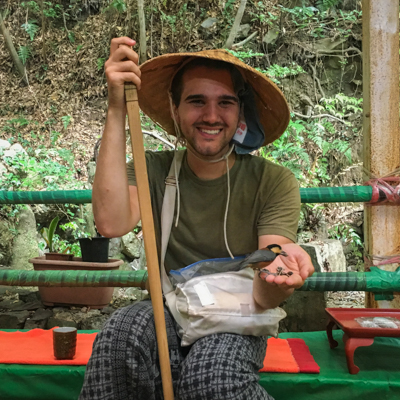
Yes, breakfast is really that early! Pilgrims - especially those walking or biking - are expected to be on the road early in the day to maximize daylight. If you sleep in, you’ll probably throw off the minshuku owner’s groove. It’s common for pilgrims to skip eating breakfast in order to get a head start.
In many minshuku and ryokan, dinner and breakfast are served communally, with all guests at the same table or in the same hall. These are almost always home-cooked traditional Japanese meals (和食) of fresh and pickled ingredients.

Because these meals are huge (made for tired pilgrims) and rice refills are unlimited, I always ended the end day with a food baby at minshuku and ryokan. Even if you’re a small-framed person, you’ll end up eating a ton because of all the calories you’ll be burning!
Minshuku meals require extensive preparation, and so you should provide notice ahead of time (at least 4-5 hours early) if you will be eating there or arriving late. If the lodging only lists prices for ‘without meals’ and ‘two meals,’ you may request one meal only, and the price will be adjusted. This happens often as it is common for pilgrims to start walking before the designated breakfast time.
Most minshuku provide free or low-cost laundry facilities/services. Be aware that many of the minshuku in Shikoku do not have WIFI.
Ryokan are another form of traditional Japanese accommodation, but they tend to operate on a larger scale than minshuku. Price are similar to minshuku, about ¥5,000 or more per person per night.
Although many ryokan provide meal options, they are usually less strict about dinner and breakfast times. This means you can request to have your meals delivered at a time that suits your schedule. Like minshuku, you should call ahead to let the staff know if planning to arrive late.
Heads up: You must take your shoes off when entering minshuku and ryokan rooms. If you are unsure when to take your shoes off, here’s a good rule of thumb: if you see tatami (bamboo mats), or if you have to step up upon entering a house or building, take your shoes off. In Japan, you should never step on tatami or step into someone’s home with your shoes on unless otherwise asked. This SoraNews24 article does a very good job explaining ryokan etiquette.
Bathing is traditionally a social activity in Japan, and many prefer larger, communal baths over private bathrooms. Most minshuku and ryokan will either have one private bathroom that guests take turns using or a public bath area. Public bath areas in Japan are gender-separated, so be sure to recognize the different kanji for male (男) and female (女).
Temple Lodging (“Shukubō”, 宿坊)
Some temples offer ryokan-style lodging to the public within temple grounds called shukubō, which are priced similarly to minshuku or ryokan.
Not all shukubō provide meal options. If you do eat at temple lodging, meals are almost always vegetarian (“shōjin ryōri”), although you may sometimes encounter meals with fish. You may also be invited to watch or partake in daily prayers and rituals as part of your stay. It is a truly special experience.
You may book temple lodging ahead of time by calling the temple, or simply ask temple staff when you go to receive your stamp (although this runs the risk of no availability at popular temples). Shukubō rooms are usually similar to minshuku and ryokan.
Hotels
In bigger cities, you will find “business hotels” that cater primarily to those on business trips seeking budget accomodations. Prices range from ¥3,000-¥6,000 (depending on your proximity to the heart of that city), and you can often make reservations online.
Hotel rooms in Shikoku are typically very small, with just enough space for you to walk around the bed and use the bathroom, and kept very clean. Basic amenities like towels, soap, shampoo, toothbrushes, toothpaste, razors, and shower caps are normally provided. Some rooms come with a television, telephone, refrigerator, or coffee maker.
Compared to minshuku and ryokan, hotels are more likely to have a private bathroom and WIFI. In some cases, pilgrims have to go down to the lobby or pay a fee to access the internet.
Most hotels and business hotels have vending machines and coin-operated laundry facilities on designated floors. If not, you can always ask the front desk whether they provide laundry delivery services to nearby laundromats. Many hotels also provide postal services at the front desk if you need to mail anything back home during your trip.
Unlike minshuku and ryokan, hotels often have staff on-hand who can speak a little bit of English!
Donation-based Lodging for Pilgrims
Zenkonyado (善根宿)
Zenkonyado are free or low-priced lodgings for walking pilgrims. The public lists for zenkonyado that allow overnight walking pilgrims is maintained by Hagimori-san (they can be found here in Japanese, English, French, and Traditional Chinese).
Owners of these pilgrim lodgings offer their space to support pilgrims on their journey. They are maintained out of “osettai spirit,” and are one of the greatest gifts you can receive during your pilgrimage. Zenkonyado are meant to just be a place for pilgrims to sleep. Do not expect anything more than bare necessities to spend a night there.
Zenkonyado are mostly community-supported passion projects built exclusively for walking pilgrims. There is a deep word-of-mouth tradition around how they are shared, and they cannot really keep up with an increased “demand” from pilgrims seeking free lodging options. If you have the means, we recommend that you opt for one of the plentiful paid lodging alternatives, and leave zenkonyado as a last resort for pilgrims in trouble. Please try not to plan your itinerary around zenkonyado stays.
In recent times, another sensitive issue in Shikoku has arisen around zenkonyado. “Permanent pilgrims” – effectively homeless vagrants that rely on free overnight housing – have been known to abuse them.
To use zenkonyado the “right way,” do the following:
- Only stay overnight at zenkonyado listed on resources that reflect Hagimori-san’s list, like our map
- Call the zenkonyado ahead of time to ensure you can stay the night
- If there is a donation box, leave a donation of at least 1,000 yen
- Leave an osamefuda (paper name slip) to show thanks to the zenkonyado owner
- Do not stay more than one night
Donation-based Temple Lodgings (Tsuyadō)
Tsuyadō (通夜堂) are donation-based lodgings for pilgrims on temple grounds. They come in many shapes and sizes: some are within concrete walls, others are wooden huts, and the one at Temple 37 is just a garage space.
Tsuyado (literally meaning “through the night”) are sparse and barebones. In the past, most tsuyadō spaces were sorrowful and deeply religious -- they acted as overnight morgues for the dead while temples were preparing end of life rites. Most of the rooms have no amenities.
Once Japan began requiring that bodies are cremated as soon as possible, tsuyado lost their historical use. Temples began repurposing them as a space for in-need walking pilgrims to stay overnight.
Tsuyado are provided as a charity by temples, and should not just be seen as a free alternative to paid lodging. They are meant to just be a place to sleep. Do not expect anything more than bare necessities to spend a night there. Please leave them as a last resort for pilgrims in trouble; you should not plan your itinerary around tsuyadō stays.
Some temples come with both a tsuyadō and a shukubō, and pilgrims have the option to pay for lodging when there is no space at the tsuyadō. We suggest pilgrims opt for the shukubō in these scenarios to support the local economy.
If you do stay at tsuyado, as space is limited, you must call between 4:00pm to 5:00pm to reserve a spot (before the temple closes). If you call earlier, temple staff are more likely to tell you to keep walking.

Temples do not allow unmarried people of mixed genders to sleep in the same room. During my pilgrimage, temple staff gave me the same advice: if I needed to stay at a tsuyadō as a woman, I should call earlier in the day to enquire about availability. If a man had already reserved or is staying at a tsuyadō, it would leave me or other female pilgrims without a place to stay that night.
This was a challenge for me – as most pilgrims are men, my requests to stay the night at tsuyadō were often turned down.
You may also be required to check in to tsuyadō before a certain time (usually before 5pm) and check out early. In general, you may not stay more than one night at a tsuyadō unless given special permission.
Keep in mind that most tsuyadō lack hotel amenities. They often do not have a place to bathe, nor any bedding. If you are not carrying a sleeping bag or tent with you, check our map to see if the tsuyadō can accomodate you (or call the temple to inquire). If you need a place to bathe, there are often public bath options nearby.
Because tsuyadō only provide a space for sleeping, all fires of any kind are totally forbidden. They mostly lack electricity, heat, and WIFI. Be sure to purchase food somewhere else prior to arriving, and clean up after yourself.
Outdoor Options
PLEASE READ CAREFULLY! Sleeping outdoors (i.e. at huts, stations, etc.) along the Shikoku pilgrimage has become a challenging topic in recent years. As the pilgrimage grows in popularity, the number of pilgrims breaking the ‘unwritten rules’ of the road too has grown.
The recommendations in this section may conflict with older English resources one can find online. The opinions of Shikoku’s locals have evolved with the growing number of pilgrims in recent years, especially foreigners.
On behalf of our team, Don Weiss, and the good people of Shikoku who hold similar views, we ask that you read the following sections carefully to understand the fluid conversation around “sleeping out” in Shikoku. Many thanks to Matsushita-san (the author of the popular 88 Pilgrimage Guidebook) for his edits and advice.
The future of the pilgrimage is at stake.
In Japan, it is illegal to camp outside unless at a campsite or designated area. That said, the Shikoku pilgrimage has long held a reputation as a trek where many choose to sleep outdoors.
Pilgrims should only sleep outside at places where it is allowed, like campsites. You may see pilgrims (both Japanese and foreign) staying the night at train stations, parks, school grounds, or in roadside temples and shrines. While this may have been tolerated in the past, the number of pilgrims pitching tents indiscriminately has grown, and local communities have grown concerned.
If you plan to camp outside, be prepared:
- Check the weather forecastGetting rained on can ruin your day and make walking miserable. If your belongings become damp or soaked, you will have to either have to carry wet items in your backpack the next day or spend hours air-drying them in the morning before you can continue your walk.Auran

This happened to me once even while sleeping in a mostly sheltered campsite – because the winds were so strong, the rain swooped in from the gaps and soaked me and my sleeping bag in the middle of the night.
Since this was along a route where I had to double back, I left my belongings to dry for several hours while I walked to Temple 38.
- Check to see whether there are sources of food and water nearby (convenience stores, public restrooms, parks)
- Prepare yourself against mosquitos. When sleeping, mosquito coils and sprays probably won’t be enough, especially after a rainy season. Consider investing in a face net (which you can find at sporting goods stores), or use a tent
- Similarly, make sure that you have access to a bathroom, and stay aware of your surroundings
Remember, it is never acceptable to sleep along the street or near areas with high foot traffic.
Roadside Stations (Michi No Eki)
Michi no eki (道の駅) are government-designated roadside stations found alongside roads and highways in Japan. Shikoku has an expansive network of toll-based roads that span from east to west and north to south, mostly along coastlines. Beginning in the 1990s, in order to promote travel and encourage people to use these expressways, the Japanese government kickstarted a nationwide project to install michi no eki along them.
Michi no eki provided free parking, bathroom facilities, telephone services, vending machines, and useful information for travelers. Because their mission is largely to promote local tourism and trade, you’ll often find unique local meals, snacks, produce, and other merchandise to buy. All the michi no eki locations in Shikoku are listed on our map.
Not all michi no eki are appropriate for pilgrims to spend the night. Be sure to research the particular michi no eki beforehand. Questions to ask include:
- Is there a suitable area/pavillion for camping nearby?
- Is the michi no eki’s near to busy cities or residential areas?
- What hours are the michi no eki open?
- Does the michi no eki provide its own guidance?
When sleeping is allowed at a michi no eki, it is typically indicated by posted signs. If you are camping in an appropriate place nearby, you can probably use the michi no eki’s bathroom facilities.

There were several michi no eki where I noticed people spending the night in their cars in the parking lot. This is common in Japan for people who are on a roadtrip, pilgrim or not.
Like most things, be respectful and – when uncertain – ask for permission (with a backup plan in mind).
Train stations
Train stations aren’t very common around Shikoku compared to the Japanese mainland, but you will be able to locate a few of them near the pilgrimage trail. Each train station has benches, restrooms, vending machines, and sometimes electricity.
That said, train stations are for riding trains, not sleeping. While there are older English resources online that share how to sleep in a train station as a pilgrim, we do not recommend sleeping in stations, even if you see others doing it. You run the risk of bothering locals, stressing attendants, and being stopped by the police.
Parks
There are often pavilions and benches in parks, sometimes dedicated to pilgrims. Though you’re free to rest at these and enjoy the park while walking, you’re not free to pitch a tent and sleep overnight.
Ask yourself, would you feel comfortable bringing your family to a park with strangers camping in it – many of them unable or unwilling to communicate with you?
Pilgrim Rest Areas or Huts
Huts are rest areas meant for taking a break while walking. They are built and provided as a form of osettai, and are a wonderful part of the pilgrimage experience. Some huts may also be suitable for spending the night.

Sleeping in huts has become a controversial topic among the people of Shikoku in recent years. Local data shows that more pilgrims than ever are walking with the aim of sleeping out… even when they carry plenty of money that could be spent at local inns.
While most of us have a romantic view of “sleeping under the stars,” the majority of pilgrims are guests in Shikoku and should respect the wishes of the locals. As the pilgrimage has grown in popularity, for many those wishes have changed.
While Shikoku’s residents are usually delighted to see walking pilgrims from all over the world, they are concerned when they sleep in public spaces, skip temple rites, ignore etiquette, and do not support local businesses.
Remember, the Shikoku Pilgrimage is not just a trek, but a cultural heritage on which a unique economy is built. If you plan to bring with you a “catch me if you can” attitude to pitching a tent wherever and sleeping on a shoestring budget, for the sake of all of us: please reconsider.
A pilgrim should carefully consider several things when deciding whether to sleep in a hut:
- Sleeping outdoors in Japan (野宿, pronounced “nojuku”) – sometimes called “urban camping” – may not be legalIf the hut is on public land, like in a park, it is probably illegal to stay overnight.
- Sleeping in huts located near urban centers, like the sidewalk of a busy road, close to a school, or within a public park, is likely to upset locals. Pilgrims have had run-ins with police asking them to vacate, especially if they pitch a tent (野営, pronounced “yaei”) or appear homeless
- Even if the constructor of a hut meant for it to be slept in, the local community are the ones who maintain it. In Shikoku, good-intentioned people have built huts around the island whose upkeep ultimately fell on locals. Even if these people are supportive of a hut for resting, it does not necessarily mean they are supportive of pilgrims staying overnightIf you find futon or pillows in a hut, consider that they may have been put there by other pilgrims or the constructor of the hut (rather than those who maintain it). You should not take these as an invitation to sleep
- If you do stay in a hut that is known to welcome overnight pilgrims, you should be prepared to leave a donation (¥1000-¥3000 yen is typical). Most huts have a donation box
- Regardless of where you choose to stay, never start a fire. This is strictly forbidden
- If you do end up staying overnight in a hut, some advise that you leave your sedge hat out so that passersbys will know you are a pilgrim
There is a contingency of experienced pilgrims (both Japanese and foreign) and Shikoku locals who have identified huts where sleeping is likely allowed. You can filter our map by huts and check for their reviews. Do so at your own risk (we cannot guarantee their legitimacy).
Campgrounds
If you want to sleep in a tent worry-free, Shikoku has many inexpensive campsites. These can be found in the official Shikoku 88 Route Guide, and many are also listed on our mobile-friendly map.

While Japan has incredibly low crime rates and Shikoku is regarded as one of the safest places in Japan, many locals strongly advise against women sleeping outdoors on their own. When I camped out, I always had at least one fellow pilgrim friend spend the night at the same site. When I walked alone, I would always opt for paid lodging to stay safe.
Shinto Shrines & Roadside Temples
It is possible to find unattended Shinto shrines and temples that at first glance seem suitable for spending the night. Some even have tatami and futons inside! But while these places may look like a great place to stay on the cheap, they are ultimately religious sites, and most Japanese associate sleeping in a shrine or roadside temple with homelessness.
Unless you have express permission from someone who oversees the shrine or temple, these places of worship are likely not an ok place to sleep. Also, shrines often do not have a restroom nearby, and many are further than a kilometer away from running water, convenience stores, michi no eki, onsen, or parks.
You may find other resources stating that shrines and roadside temples are a good option when camping out. Much of this information is outdated and has not kept pace with the changing sentiment of Shikoku’s locals.
If you do get permission to stay at a shrine or roadside temple, remember to show respect and reverence. Take off your shoes, clean up after yourself, and do not sully religious or historical artifacts.
The Future of Sleeping Outside
When it comes to sleeping out, issues that were once small and occasional have become real causes of concern. These are exacerbated by the many older English-speaking websites about the pilgrimage condoning “roughing it” with a wink and a nudge.
If the Shikoku pilgrimage hopes to grow gracefully while retaining its authentic charm, it needs everyone’s help. Pilgrims must support the local communities that make the journey special, both in spirit and in practice. Our take? Stay at local inns or hotels when you can… and if you are hellbent on sleeping outside, make sure it is allowed and not unsightly.
Making Reservations
You may choose to use reservation websites like Rakuten Travel, Booking.com, or Agoda, especially when looking for accomodations in a larger city. In more remote regions, the common way to make a reservation is by phone. If the minshuku or ryokan is away from the path of the pilgrimage trail, you might be able to ask the innkeeper for a ride to and from their place.
A great number of minshuku and ryokan don’t accept online reservations. Some of them might not even appear on search engines. To find suitable places to make a reservation, we recommend the following:
- Search and filter results with our interactive map. If you prefer to use your phone or laptop to plan, our mobile-friendly map has hundreds of listings. You can filter by price, type of place, facilities, languages spoken, and more
- Consult your guidebook. The standard Shikoku 88 Pilgrimage Route Guide contains the addresses and phone numbers of many accommodations
Many places in Shikoku still only accept reservations over the phone. If your mobile phone is not able to make calls within Japan, you may be able to find phone booths near roads or post offices. Here is a list of useful Japanese phrases when making a reservation (it is unusual for minshuku or ryokan personnel to speak English).
An important note about cancellations: It is considered very rude and extremely unusual for Japanese people to cancel their booking reservations – especially reservations for minshuku or ryokan, where the meal ingredients are purchased early in the day and preparations can take several hours.
As the number of foreign pilgrims increase, it has become more common for minshuku and ryokan owners to receive cancellation requests. For this reason, we strongly advise pilgrims to avoid canceling, especially at the last minute. If you know you will be unable to reach your anticipated destination for the night, consider taking public transportation or asking for a ride from the minshuku or ryokan owner, then returning to that point the next morning to continue your walk.
Laundry Services
Many minshuku, ryokan, and hotels have washing machines. Minshuku sometime provide them for free. Otherwise, a washer typically costs ¥100-200 per load, and a dryer costs around ¥100 per 30 minutes. You can filter by places that provide laundry services on our interactive map. As an alternative, many towns and cities along the route will have at least one laundromat.
Not all minshuku and ryokan will have dryers. For this reason, it is wise to invest in clothing that dries quickly. If there is a heater or air conditioning in your room, take an early bath so that you can hang dry your washed clothing next to it overnight. As you will be constantly waking up early and on the go during the pilgrimage, it is difficult to dry your clothes under the sun.

In a pinch, I found that spreading my pilgrim robe over my backpack as I walked did eventually dry it out throughout the day.










